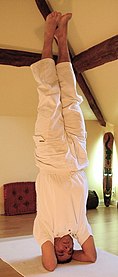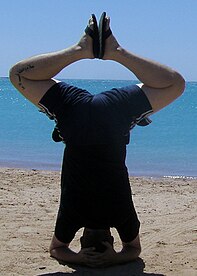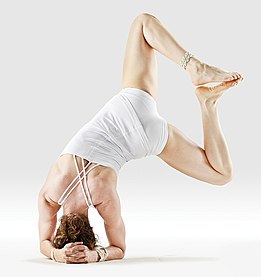Headstand
Appearance

The headstand, or sometimes head stand, is a pose that is an inversion posture of standing head down. The technique is used in different settings such as yoga, breakdancing, acrobatics and beginner gymnastics.
How to practice headstand
- Start from kneeling position on mat and put your forearms on the floor in front of you.
- Weave your fingers together and lie on your head, making a stable “tripod” with your hands and head.
- Pressure your hips and straighten your legs, under your toes, until your hips are vertically above your shoulders.
- Engage your core and peel your legs off the ground at the very start when moving them towards the ceiling.
- Keep the steady position between your hands or to your toes and don’t let your head go down, but rather keep a straight line from head to heels.
- Breathe for a few moments, then gradually add duration to your pose with your strength and comfort level growing.
- To exit the pose, lower the legs slowly back down with the support of your hands and then lower yourself to a kneeling position.
Health risks
- If the headstand is not done perfectly, the performer is likely to suffer head injury from standing on the head.
- if one is suffering from high blood pressure, they should avoid headstand.
In yoga
The yoga headstand, Shirshasana, may be balanced and symmetrical from all perspectives, even though not always in a legs-vertical position. The asana has many variations, several of them asymmetrical.
-
Yoga headstand, Shirshasana
-
With feet as in Baddha Konasana
-
A variation
See also
References
External links
- A video of a head stand
- Freeze and Headstand Tutorial Archived 2020-08-11 at the Wayback Machine



